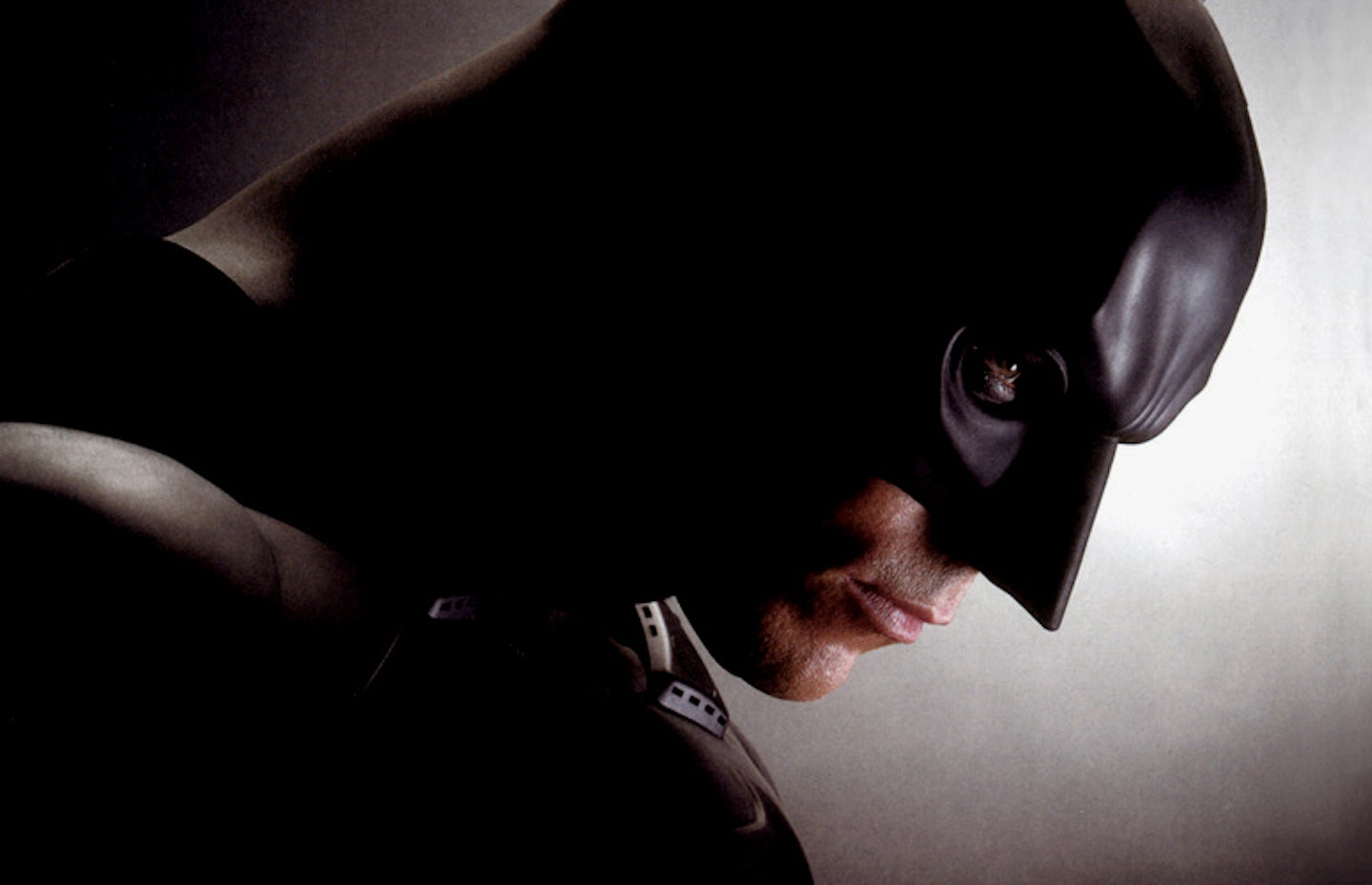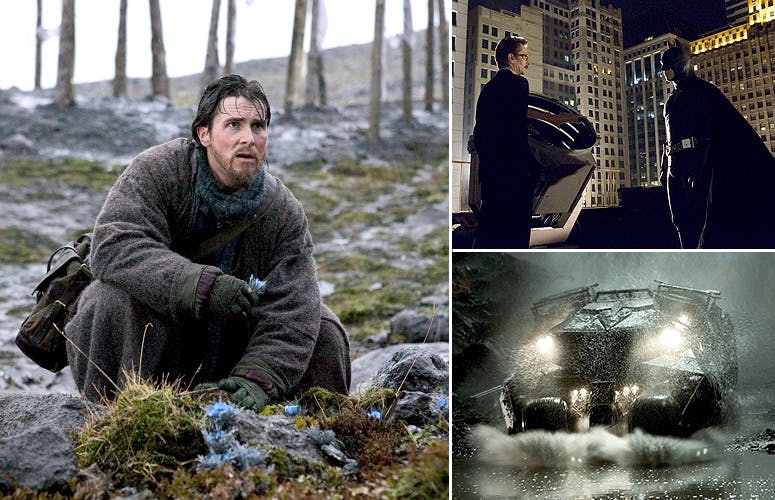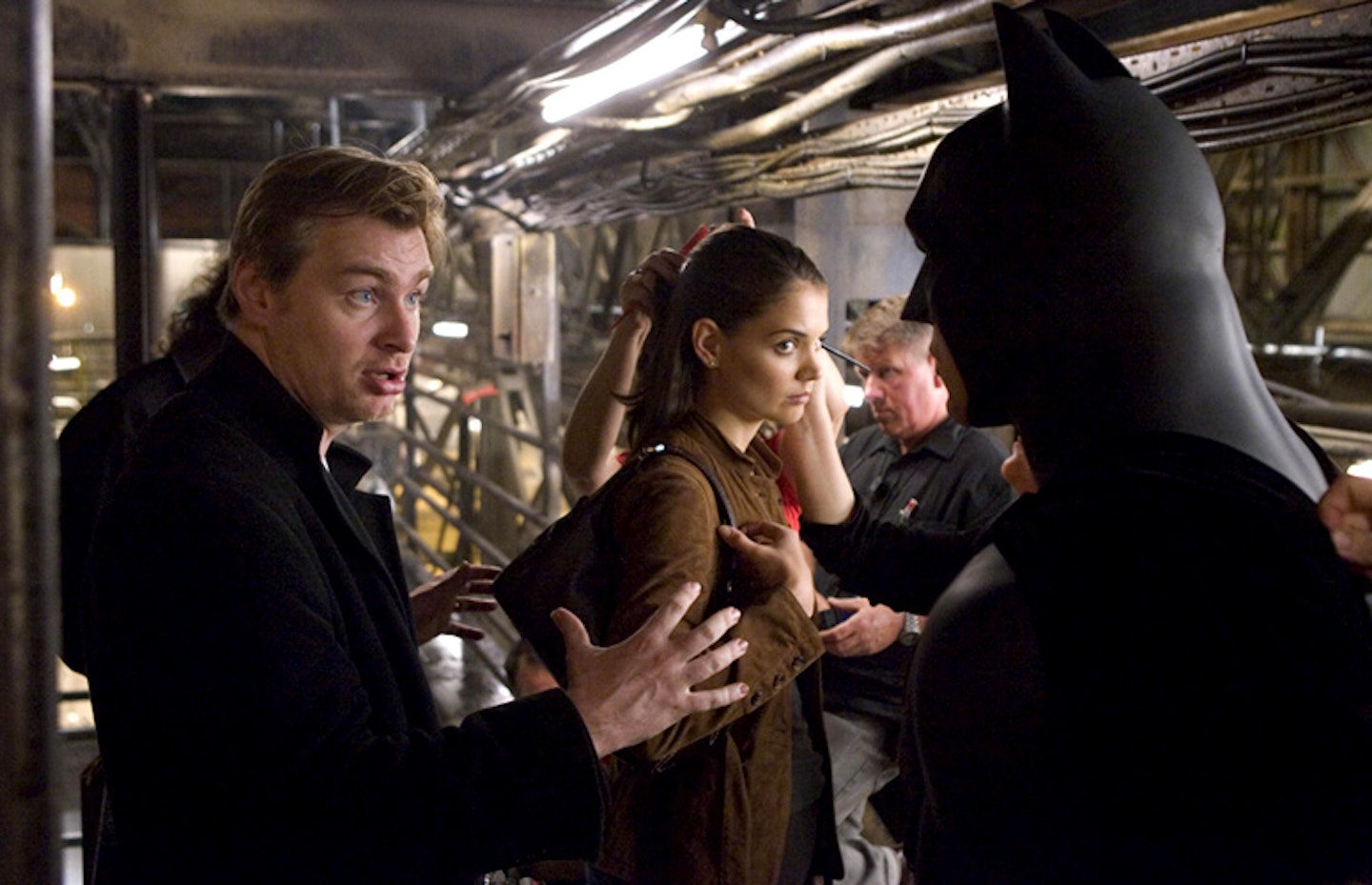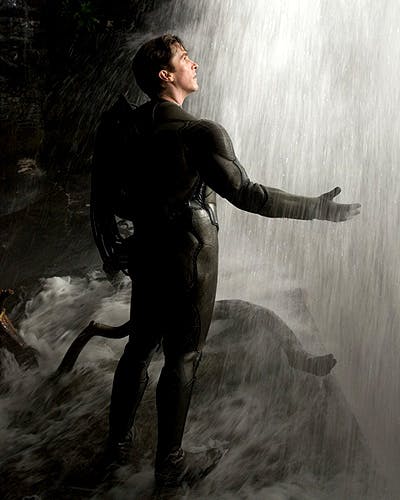After the Day-Glo Schumacher years, how would star Christian Bale and director Christopher Nolan reveal the darkness and depth to make the Caped Crusader credible? Empire traveled to Gotham City and beyond to see the dynamic duo give a reality check to Batman Begins...
This article was first published on July 2005 in Empire magazine. Subscribe today{

THE SLEEK PEOPLE CARRIER COMES SLOWLY TO A STOP on the sun-baked tarmac. Inside there is movement. There are, apparently, announcements to be made...
*“There will be absolutely no photography,” says a PR.* > > *“No cameras at all,” adds another.* > > *“Please stay with us at all times,” continues the first. “Don’t wander off.”* > > *“Phones!” says the second.* > > *“If you have a camera phone, then you absolutely mustn’t use it…”* > > *“Not even a snap just for a souvenir or anything like that…”* > > *“In fact, all phones must be switched off,” concludes the first, making it sound as if she’d actually prefer if they were thrown to the Tarmac and ground under foot, one by one.*
Empire is on a charabanc trip to Gotham City. Security is vice-tight. And we’re only at Toddington Services.
Gotham City turns out to be located, somewhat incongruously, near the hamlet of Cardington in deepest Bedfordshire. It’s the kind of leafy English village where rabbits frolic in verdant meadows, pints of foaming ale host impromptu wasp conventions in pub beer-gardens, and effigies of asylum seekers smoulder gently on the village green. But looming in the distance are a couple of gargantuan structures that don’t belong in this delightful rustic landscape at all. They dominate the horizon. They are, to put it bluntly, a pair of the biggest bloody sheds in the world.
Originally built as assembly plants for airships (ominously, a photograph exists of the Hindenburg floating above one of them) at the beginning of the 20th century, Cardington Airships Sheds are among the largest structures in Europe. The statistics hammer the point home: for example, Warner Bros’ largest studio is Stage 16 in Burbank (it’s where they shot The Perfect Storm). You could fit six-and-a-bit of them into a single one of these sheds. Let’s put it another way – if you happened to want to hide RMS Titanic, you’d only have to saw 40 feet off her to fit her inside and close the doors.
But what’s actually inside today is almost as fantastic. An entire city block seems to have been carved out and slammed down into the middle of Shed 2. Its meticulously detailed buildings tower eight storeys high; lines of washing dangle between tenements; there’s a fully functional monorail running down one side; and it seems, while Empire is there at least, to be permanently pissing it down.
“They’ve amazed me again and again and again,” says Christian Bale, wandering over. “The amount of engineering that has gone into all this stuff is phenomenal, and we’re using as little computer imagery as possible, which I like.” He’s not, for now, suited up – instead he’s wearing the slightly less fetishistic garb of trackie bottoms and a dressing gown. He does, however, have two large shiny black panda-eyes painted on, intended to augment the mask (“Have I still got those on?” he murmurs later. “I promised myself I wouldn’t do interviews looking this odd. You won’t mention it, will you?”)
Bale is halfway through a shoot which in the end will clock in at an astounding six months. Eight or so weeks ago he was rolling around on the glaciers of Iceland, scrapping with Liam Neeson; at Shepperton Studios the Batcave studio where they spent weeks jumping a full-size, two-and-a-half-ton Batmobile through the waterfall entrance is no doubt only just being dismantled. Next week the whole production will relocate to Chicago, where cops will seal off unprecedented swathes of the city centre to stage the film’s climactic car chase. Like the sheds, the whole movie is big. But far from making the role more tempting for Bale, it originally just added to the doubts he had about donning the cape and cowl in the first place.
%20*Clockwise%20from%20left.%20Bruce%20Wayne%20begins%20his%20journey.%20Batman%20gets%20acquainted%20with%20Commissioner%20Gordon%20(Gary%20Oldman?auto=format&w=1440&q=80)
For a start, the Batman franchise still had the faint but unmistakable stink of its final ghastly descent into manic campery. And then there was the fact that he really wasn’t a long-time comic book devotee. “I wasn’t interested in the character at all, “ Bale says. “I had seen the TV show and hadn’t really liked it, but it was four or five years ago when I was working with a director who was really into graphic novels. He gave me Batman: Year One. What I suddenly saw was that there was this character here that I never knew from the movies and TV series. He wasn’t just a bland superhero who does nothing but jump around. The most attractive thing about him, as opposed to Spider-Man and Superman, is the conflict.”
Bale pauses, considering a way of expressing the fundamental differences. “Look, put it like this. If all the other superheroes were sitting together here in this room, they’d all be getting along fine with each other, but they’d be thinking, ‘What’s wrong with that dude sitting over there?’”
Bale had heard rumours that Pi director Darren Aronofsky was working on a down-and-dirty, low-budget take on Year One which he intended to be rated R. It sounded exactly like the way Bale would have wanted to play the role, but before he could make his interest known, the project stalled. “It seemed after that that the film was just getting bigger and bigger,” says Bale, admitting that he had pretty much lost interest again by that point. “But then I heard Chris Nolan was directing. Then I was very interested again. I though that, unless he’s lost his mind, he’s not going to want to make the same kind of Batman movie again.”
What Nolan described to Bale when they finally met was indeed a very different kind of Batman movie. Whereas in the previous films the vigilante mammal’s distinct lack of any actual superpowers had been made up for with super-technology, Nolan intended his story to be set in a much more realistic milieu graced with credible gizmos.
“We met, and what he described to me sounded perfect,” says Bale. ‘The story explains how everything came to be. The Batmobile, for example, comes from a military background via Wayne Enterprises. It was just too expensive for the military to buy.”
Bale himself at that time, however, looked much less than perfect. Having just shot The Machinist, for which he shed an astonishing 80lb, he was anything but the muscled athlete he needed to be for the role. Cue a lifestyle revolving mostly around push-ups and pizza. “Look, what doctor is going to say to me that in the space of a year it’s healthy to go from 120 to 220lb and then down to 190?” he snorts when we asked if this was strictly wise.
A bell rings, and the torrential downpour starts to douse Gotham again. Bale heads off to squeeze into the rubber tights. “Chris Nolan is pretty busy, so he won’t have time to do an interview,” PR number one confides. ‘But he might pop in and say hello.” A few minutes later, Chris Nolan pops in.
“Hello,” he says.

“HELLO,” SAYS CHRIS NOLAN, standing in the middle of a sea of packing crates and half-filled suitcases. “Just dismantling the house,” he continues cheerily.
It’s nine months later, and Nolan and his family are preparing to move from England, where he’s been editing the film, back to their home in LA. He’s just returned from the developing lab and, after Empire’s chat, will head there again to check the final reel. Batman Begins is literally hours away from completion.” It just sort of dribbles away,” he muses when asked about how the process of making a film actually ends. “You don’t sign a piece of paper – you know, ‘Here’s the finished film.’”
Nevertheless, it is all just about to be over, and it’s been a long haul. “My eldest is two years old,” he says to illustrate the timescale. “I can remember when he was born. We were sculpting the model for the Batcave in my garage, then we had to rush of to the hospital. On his first birthday we were actually shooting on that set.”
Batman Begins itself began amid the wreckage of an abandoned Nolan project. He had been working for over a year on a Howard Hughes movie, with Jim Carrey set to star. When Martin Scorsese announced that he was about to start The Aviator, Nolan’s project, a little like its subject, crashed and burned. “I guess I just didn’t write quickly enough,” he says ruefully. “So I just decided to make a film about a different millionaire eccentric…”
In fact, Nolan had been interested in Batman for years. He’d watched the ‘60s TV series as a kid and then later the Burton/Schumacher films. Neither answered the questions he had about the character. Finally, after the abandonment of the Hughes project, word reached him that Warner Bros were noodling with the idea of reviving the Batman brand – a franchise that had been, in popular fan-opinion, if not actually murdered by Schumacher’s Batman & Robin then at least subjected to Abu Ghraib-style indignities. They had an idea that they wanted to take it in a very different direction (who wouldn’t?), but they had no idea what that direction might be. Nolan was introduced to screenwriter David Goyer (Blade, Dark City) who had also been circling the project. Nolan and Goyer found that they had very definite ideas of what their Batman should be, and – more importantly – about what it wouldn’t.
“It speaks volumes about the almost elemental nature of the character that it can remain fascinating even when presented in such a campy way,” says Nolan. “What I felt is that I’d never seen the film of Batman that I figured someone would have done back in 1978 to ’79, after Dick Donner made that great Superman film. They’d never shown you how Bruce Wayne becomes Batman. That was the story that I wanted to see on an epic scale.” The previous movies, he felt, had been exercises in style rather than drama and had boiled off much of the emotional reality that could make the legend compelling.
%20

 “Tim Burton came along in ’89 and took a very stylized, idiosyncratic approach. It was truly visionary,” Nolan continues. “Burton’s Gotham is so extraordinary that Batman becomes part of the environment. I think that was their way of selling the audience who had seen the TV show on the idea of there being a cool Batman film. We don’t have that baggage, so we’re able to do what I always wanted to do, which was to have a relatively recognisable world were Batman is an extraordinary element.”An early working title for Goyer and Nolan’s screenplay was Batman: Intimidation. It’s an intriguing hint as to what their film takes as its theme. Unlike the visual attractions of Burton’s pop-expressionist whimsy of Schumacher’s comic-book campiness, Nolan was interested in the psychology; he wanted to get under the cowl, to investigate what made the Dark Knight go dark in the first place. His and Goyer’s answer to the conundrum emerged as a single word: fear.
“Tim Burton came along in ’89 and took a very stylized, idiosyncratic approach. It was truly visionary,” Nolan continues. “Burton’s Gotham is so extraordinary that Batman becomes part of the environment. I think that was their way of selling the audience who had seen the TV show on the idea of there being a cool Batman film. We don’t have that baggage, so we’re able to do what I always wanted to do, which was to have a relatively recognisable world were Batman is an extraordinary element.”An early working title for Goyer and Nolan’s screenplay was Batman: Intimidation. It’s an intriguing hint as to what their film takes as its theme. Unlike the visual attractions of Burton’s pop-expressionist whimsy of Schumacher’s comic-book campiness, Nolan was interested in the psychology; he wanted to get under the cowl, to investigate what made the Dark Knight go dark in the first place. His and Goyer’s answer to the conundrum emerged as a single word: fear.
“When you sit down to analyse how you tell the story of Bruce Wayne becoming Batman realistically, what’s the biggest problem?” he says. “Well, it’s making the audience believe that there’s this guy who’s going to dress like a bat. Why does he do it? The answer is that Bruce Wayne has to construct this symbol of fear, so that he becomes more than just a man and so he can turn fear inflicted upon him against those who intimidate us; he’s almost using a kind of branding to get under the skin of those he’s battling. The idea that you can use fear as a weapon is a very strong undercurrent in the film. In our telling of it, Bruce Wayne’s worst fear is the bat. That’s why he chooses it.”
It’s an interesting idea and, perhaps not by coincidence, one which possibly melds with today’s jittery zeitgeist. With politicians from all sides playing on the public’s heightened fear of violent crime, and a widespread sense of impotence to protect themselves, doesn’t this have the potential to become an exploitative revenge fantasy, just Death Wish in kinkier threads?
“To me, Batman can never be Charles Bronson in Death Wish,” Nolan says. “He doesn’t kill, he doesn’t use guns. He is extraordinarily frightening and threatening, but in the end he’s on the side of the angels.”
But there is the obvious fact that one of Bale’s most notable roles pre-Batman is Patrick Bateman in American Psycho, another film about a man with a split personality dwelling in a modern dystopia. “Of course it was very much in my mind,” confirms Nolan. “I was blown away by that performance. There was this very edgy, very dangerous set of thoughts going on behind Patrick Bateman’s eyes. And Bruce Wayne has that. He is a very dark character, but ultimately his decision is altruistic: he’ll fight to stop what happened to him happening to other people. He’s this flawed, human heroic figure being driven by very negative impulses – rage, anger, guilt and fear – but he challenges them into something positive; that’s the essence of what distinguishes Batman from a psychopath.”
It can, of course, only be coincidence that Bateman and Batman are separated by a single vowel…
Towards the middle of Batman Begins, there is a stunning, bravura shot. Nolan’s camera hurtles over Gotham City until it spies the silhouette of a dark figure perched atop a towering skyscraper. We whirl and spin dizzyingly around him as his cape flaps and billows in the wind. It’s an astonishing, God’s-eye-view of The Bat surveying his territory. When Michael Caine first saw the sequence, he told Nolan that it was the single best use of CGI he had ever witnessed. Nolan must have had cause to smile to himself. There was, in fact, not a single computer-generated element in the shot. It had been realized by strapping a stuntman to a skyscraper in Chicago (which doubles for Gotham City in the film) and flying helicopters at him all night. It was all part of Nolan’s ruling idea: everything in his Gotham that conceivably could be was always going to be absolutely for real.
“I was in the helicopter,” Nolan smiles. “The double was a great stuntman called Buster Reeves. I wouldn’t like to speak for Buster, but I think he confessed to just a tiny touch of nerves.” But the aversion to digital pokery is unusual, particularly in a summer that will see some of the most pixel-heavy movies of all time land on our screens. “I just felt that I and audiences around the world were getting used to those tricks,” he says. “They were fresh ten years ago, they’re not fresh anymore. It looks artificial. When you go to see a big blockbluster these days, you might as well be watching Toy Story. Well, Toy Story’s great, but it’s animation. I wanted to see something real. Batman is the most real superhero, he is the guy who has no superpowers, he’s just a rich guy who does a lot of push-ups.”
Appropriately enough, it is the middle of the night when Christian Bale calls from Los Angeles. Nolan has shown him the completed movie, and Bale is apparently well pleased. “I really think we got what we wanted,” he says. “It’s a damned good result. It’s grittier, darker, the complete genesis story. I’m very happy with it. I’m sure Chris is too.”
It of course leaves the open question of the future. Bale is signed up for another two; Nolan says that, in theory, he might be interested in helming a second. “It did feel strange taking that cowl off for the final time. I mean, I didn’t miss the fucking terrible headaches it gave me,” says Bale. He pauses before continuing. “But you do look at it and think, ‘Damn, it’s a sad thing.’ You think, ‘Am I ever going to be putting that on again?’”
Head back to our Dark Knight trilogy hub for more exclusive features, interviews and competitions.
 ![Empire Dark Knight Rises iPad Edition] The iPad Edition
![Empire Dark Knight Rises iPad Edition] The iPad Edition
For the full story, download our collector's edition on iPad.
